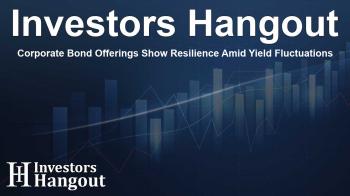Corporate Bond Offerings Show Resilience Amid Yield Fluctuations

Understanding the Surge in Corporate Bond Offerings
The U.S. corporate debt market is seeing a remarkable surge in bond offerings, largely influenced by climbing Treasury yields. This trend reflects a heightened demand for corporate debt amidst fluctuating borrowing costs.
Market Dynamics Fueling Corporate Debt Activity
As companies strive to secure funding before potential increases in borrowing costs, approximately $75 billion worth of investment-grade bonds were issued in just the first week of the year. This rapid pace illustrates how companies are reacting to changing market conditions with urgency.
The Impact of Treasury Yields
With rising Treasury yields, companies are incentivized to issue bonds as a means to maintain favorable financing terms. However, this increase in yields can also heighten anxiety in the financial markets, leading to a complex balance between opportunity and risk.
Investor Sentiment and Corporate Spreads
Despite concerns about looming volatility, investor sentiment remains robust with a growing appetite for higher yields. This demand is helping to moderate the pressure on corporate credit spreads, thereby mitigating some of the potential ramifications of rising yields on borrowing costs.
Future Outlook for Corporate Bond Issuance
Looking ahead, predictions suggest that the issuance of corporate bonds may reach between $175 billion and $200 billion in January alone. If the upper end of this projection is achieved, it could signal only the fifth occurrence in history where monthly issuance hits that threshold.
Key Events and Market Influences
However, market dynamics may shift with upcoming events, including a shorter market session in observance of the late 39th U.S. President and key job data releases. Historically, U.S. companies tend to minimize bond issuance prior to earnings announcements, which typically occur later in the month.
Strategic Considerations for Investors
Investors must remain vigilant as the market navigates a combination of rising yields and tightening spreads. Understanding how these factors can intertwine will be crucial for making informed investment decisions in the coming weeks.
Frequently Asked Questions
What has caused the recent surge in corporate bond offerings?
The surge is largely driven by increasing Treasury yields and companies seeking to secure funding before potential future rate hikes.
How much corporate bond issuance is expected in January?
Projections estimate that corporate bond issuance could reach between $175 billion and $200 billion this January.
What challenges do rising Treasury yields pose?
Rising yields may create volatility in financial markets and influence corporate borrowing costs, potentially affecting investor strategies.
How do investor sentiments affect corporate credit spreads?
Strong investor demand at higher yields can help to stabilize credit spreads, balancing the impact of rising yields on funding costs.
Will upcoming events impact bond issuance?
Yes, events such as shortened market sessions and the release of earnings reports may slow down the pace of bond issuance.
About Investors Hangout
Investors Hangout is a leading online stock forum for financial discussion and learning, offering a wide range of free tools and resources. It draws in traders of all levels, who exchange market knowledge, investigate trading tactics, and keep an eye on industry developments in real time. Featuring financial articles, stock message boards, quotes, charts, company profiles, and live news updates. Through cooperative learning and a wealth of informational resources, it helps users from novices creating their first portfolios to experts honing their techniques. Join Investors Hangout today: https://investorshangout.com/
Disclaimer: The content of this article is solely for general informational purposes only; it does not represent legal, financial, or investment advice. Investors Hangout does not offer financial advice; the author is not a licensed financial advisor. Consult a qualified advisor before making any financial or investment decisions based on this article. The author's interpretation of publicly available data shapes the opinions presented here; as a result, they should not be taken as advice to purchase, sell, or hold any securities mentioned or any other investments. The author does not guarantee the accuracy, completeness, or timeliness of any material, providing it "as is." Information and market conditions may change; past performance is not indicative of future outcomes. If any of the material offered here is inaccurate, please contact us for corrections.
